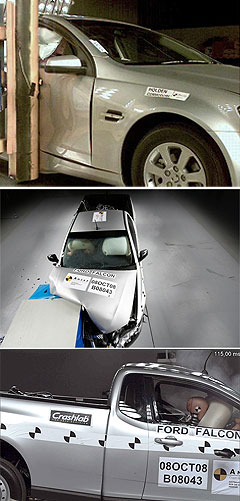Make / Model Search
News - Holden - CommodoreCommodore now a five-star safety carPoles apart: Holden has made significant improvements to the VE Commodore in order to reach a five-star ANCAP rating. ANCAP elevates Commodore’s crash-test rating to a maximum five stars4 Dec 2008 By TERRY MARTIN HOLDEN can now claim the VE Commodore is as safe as Ford’s FG Falcon with the upgrading of its Omega sedan to a five-star rating from the Australasian New Car Assessment Program (ANCAP). All other models in the Commodore sedan range remain with an inferior four-star rating from the independent crash-test regime because one of the crucial additions needed for the extra star, a passenger seatbelt reminder, will not be fitted on these variants until mid-2009 production. Other alterations to the Commodore that have assisted with the ratings upgrade include the introduction across the range of a redesigned steering column shroud, which is designed to reduce driver knee injuries, and modifications to the rear doors that prevent them from coming unlatched in the event of a crash – as one did in the original ANCAP test. The fact that all Commodores now have side and curtain airbags as standard also contributed to the improved result. “You can say that Commodore is now as safe as Falcon,” said ANCAP representative and RACV chief engineer Michael Case, despite the fact that the FG Falcon scored 34.61 out of 37 and the Commodore 33.45. “In a broad sense it’s now as safe as the Falcon because it’s a five-star NCAP vehicle. “Technically, there’s still a slight difference in their score, and numerically the Falcon has a slightly higher score than the Commodore. But it’s hard to draw a conclusion that that means that one is really safer than the other.”  Left: The Holden VE Commodore and (below) Ford's FG Falcon ute, which would have scored five stars if Ford Australia had paid for a pole test. Left: The Holden VE Commodore and (below) Ford's FG Falcon ute, which would have scored five stars if Ford Australia had paid for a pole test.GM Holden chairman and managing director Mark Reuss welcomed upgraded result and the ANCAP endorsement. “We have always been very confident of this vehicle’s real-world safety capabilities,” Mr Reuss said. “Before we launched VE, we conducted almost 80 real-world prototype crash tests and more than 5000 crash test simulations using leading-edge virtual technology. “When it comes to safety we are committed to continually improving the passive and active safety features we offer. We are also pleased to see that ANCAP now acknowledges electronic stability control in determining its ratings.” The latter become a requirement for a five-star rating from ANCAP at the beginning of this year. An optional pole test, demonstrating the vehicle’s crash performance in a side impact, is also often required to achieve five stars. Interestingly, Ford Australia chose not to submit its Falcon-based FG ute to the pole test, which meant that the four-star result also released today was the highest it could have achieved. Mr Case confirmed to GoAuto that with the two extra points that comes with a successful pole test, the FG ute would have achieved five stars, becoming the first Australian-built light commercial to reach the coveted level. “It’s an optional, additional test funded by the manufacturers. That usually means that the manufacturer is not likely to want to do it unless it’s going to enhance their star rating, and mostly that means that otherwise the vehicle is at, say, ‘high four’ stars,” Mr Case said. “My understanding is that if they (Ford) had done the pole test, and met the requirements of that test, they would have got five stars. The reason that they haven’t done it, only they can answer.” Prior to the test, FG Falcon chief engineer David Wilkinson told GoAuto that the ute was expected to have no trouble getting the five-star rating. “Structurally, there are no issues at all,” said Mr Wilkinson. “Even the side barrier engages the strong part of the car. It’s a smaller cabin and in some ways it’s stiffer than a larger cabin because you’ve got the back panel going across the car.” However, Ford Australia communications manager Sinead McAlary explained the decision to GoAuto. “Although the inherent design and engineering of the Falcon ute provides customers with similar safety benefits to Falcon sedan customers, neither side airbags or stability control are standard across the Falcon ute range which would have made the five-star message more difficult to communicate,” she said. “We prefer to keep our safety messages simple and consistent as possible, and a strong four-star result is still very competitive in this segment of the market. As a result, we decided in this instance not to provide a vehicle for, or pay for, the pole test.” ANCAP chairman Lauchlan McIntosh said he was disappointed that commercial vehicle owners did not have the same level of reassurance as those of passenger cars. “ANCAP is still waiting for the breakthrough of a five-star commercial vehicle so that tradespeople, couriers and other such vehicle users can have the same level of safety as company executives,” Mr McIntosh said. Critics of the NCAP regime argue that requirements such as the manufacturer-funded optional pole test and the inclusion of items such as a passenger seatbelt reminder warning light, which is unrelated to the vehicle’s crash performance, limit the effectiveness of the five-star rating. However, Mr Case said safety features that ensured the occupants were well harnessed, and which prevented a crash from occurring in the first place, were important prerequisites in ensuring the vehicle was worthy of the maximum ANCAP rating. “The requirement for the seatbelt reminder has really come to ANCAP from Euro NCAP, and it’s on the basis of how important it is for the occupants to be wearing seatbelts. It’s seen that the seatbelt reminder does maximise the seatbelt wearing rate,” he said. “The assessment is not just how it (the car) goes in the crash. It’s trying to protect the occupants through making sure they’ve got their seatbelts on, and it’s also giving them the chance of avoiding the crash through having ESC.” Mr Case also insisted that the VE Commodore, before the latest modifications, was some distance from being a five-star car – a fact borne out by its first test score of 27.45 out of 37. “It was only a four-star car. There was some difference between where it was at four stars, and where it needed to be to get to five stars. So those issues – the steering column shroud and the rear door unlatching in that (original) test – are significant issues that needed some time and redesign work by Holden. “It wouldn’t have been quick, easy or necessarily cheap to have fixed any of those problems. They took a bit of time. And they’ve made a fundamental difference to safety performance of that vehicle, as assessed by NCAP.” The remaining Australian-built large cars still on the new-car market – the Toyota Camry and Aurion – each achieved four stars under ANCAP. GoAuto understands that a pole test would see both vehicles reach the five-star level. Other results published by ANCAP today were a four-star rating for the Honda Jazz mini-car and three-star ratings for the following: the Nissan Micra light car, the Nissan Navara D22 4x2 one-tonne ute, and the rival Isuzu D-Max 4x2 and 4x4 one-tonners. It is understood that these results are based on Euro NCAP results, with local specifications and slight differences between the Australian and European NCAP rating systems taken into account. That could explain why the Holden Rodeo/Colorado-based D-Max was slapped with a two-star (with a strikethrough) rating in Europe earlier this year but climbed to three in Australia. “There’s a minor difference in the assessment of the result, but even at three stars that’s less than the level that we would be recommending car-buyers look for,” Mr Case said. “Three stars is disappointing in these days when nearly every vehicle has got four stars, and a high percentage are now getting five stars. “People really need to be looking at five stars, or at the very least four stars. Three or two are well off the pace.” ANCAP makes separate assessments for pedestrian safety, and handed down a dismal one-star rating (out of four) for the D-Max, Navara – and the Commodore. The Falcon ute and Micra scored two stars, and the Jazz three. Earlier this week, Holden introduced the option of a reversing camera across its VE Sportwagon range – a feature that works in conjunction with rear parking sensors to improve the driver’s rearward vision. Buyers of all Sportwagon model variants, including the Calais, must pay an extra $500 for the camera. It utilises the dash stack’s LCD screen on Calais, Calais V and SS V, while lower-series models have a screen incorporated into the rear-vision mirror. “This is a significant, competitively priced feature that will enhance safety for passengers and pedestrians,” said GM Holden marketing director Philip Brook. “Sportwagon has strong appeal to customers with young children where safety is a key priority in their decision to purchase a new car. “It’s an essential tool for people who need to park in tight spaces or hitch their vehicle to a trailer, caravan or boat.” Read more:Five-star safety falloutFour-star Commodore safe, says Holden Five-star Falcon! VE safe: Holden |
Click to shareHolden articlesCommodore pricing
Motor industry news |









Facebook Twitter Instagram